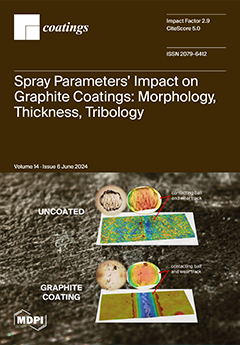Objective: This study aimed to assess the effect of four different surface-coating agents on the microhardness, water sorption, and solubility of the highly viscous glass ionomer cement EQUIA Forte
® HT. Materials and methods: A total of 100 cylindrical EQUIA Forte
® HT
[...] Read more.
Objective: This study aimed to assess the effect of four different surface-coating agents on the microhardness, water sorption, and solubility of the highly viscous glass ionomer cement EQUIA Forte
® HT. Materials and methods: A total of 100 cylindrical EQUIA Forte
® HT samples were examined, with 50 tested for Vickers hardness and the other 50 for water sorption and solubility. For each test, the specimens were divided into five groups (10 specimens/group) according to coating method: Group 1—no coating (control), Group 2—EQUIA Forte
® Coat, Group 3—Single Bond™ Universal Adhesive, Group 4—ExciTE
®F adhesive, and Group 5—petroleum jelly. Data were analyzed using the paired
t-test, one-way analysis of variance, and Tukey’s post hoc test for multiple comparisons. Statistical significance was set at
p < 0.05. Results: The mean microhardness of the coated groups was significantly higher than that of the uncoated group. Moreover, a significant difference in the microhardness value was detected between the coated groups. Furthermore, EQUIA Forte
® Coat had the highest mean hardness value. The mean water sorption at 7 days showed that EQUIA Forte
® Coat had the lowest values. In terms of water solubility, a statistically significant difference was found between no coating and all groups except EQUIA Forte
®, between Single Bond Universal Adhesive and petroleum jelly, between petroleum jelly and EQUIA Forte Coat, and between EQUIA Forte
® Coat and ExciTE
®F. Conclusions: The study revealed that all coating agents significantly increased the microhardness of EQUIA Forte
® HT, with EQUIA Forte
® Coat showing the highest hardness and the lowest water sorption values.
Full article





